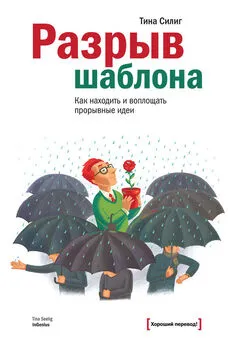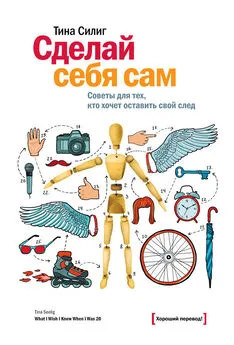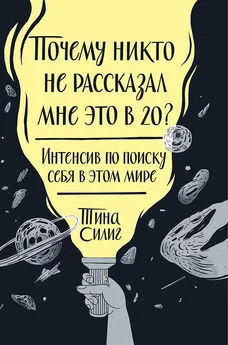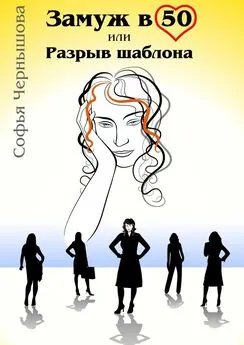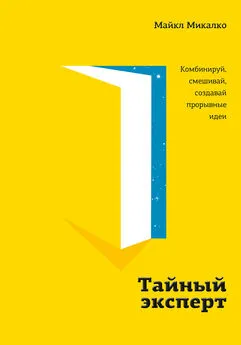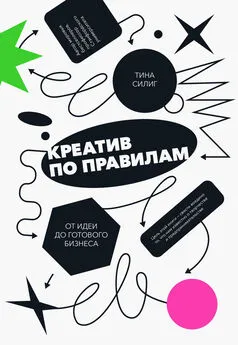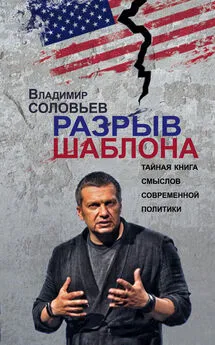Тина Силиг - Разрыв шаблона. Как находить и воплощать прорывные идеи
- Название:Разрыв шаблона. Как находить и воплощать прорывные идеи
- Автор:
- Жанр:
- Издательство:Манн Иванов Фербер
- Год:2015
- Город:Москва
- ISBN:978-5-00057-403-4
- Рейтинг:
- Избранное:Добавить в избранное
-
Отзывы:
-
Ваша оценка:
Тина Силиг - Разрыв шаблона. Как находить и воплощать прорывные идеи краткое содержание
Это книга подходит для всех, кто хотел бы раскрыть творческий потенциал в себе и своих сотрудниках или коллегах.
Разрыв шаблона. Как находить и воплощать прорывные идеи - читать онлайн бесплатно полную версию (весь текст целиком)
Интервал:
Закладка:
45
Ewan McIntosh, “Clicks & Bricks: When Digital, Learning, and Physical Space Meet,” October 3, 2010, edu.blogs.com.
46
Видео Мариссы Майер можно найти на ecorner.stanford.edu.
47
Teresa Amabile, Constance Hadley, and Steve Kramer, “Creativity Under the Gun,” Harvard Business Review, August 2002.
48
Видео Стефании Тилениус о eBay можно найти на ecorner.stanford.edu.
49
Eric Ries, The Lean Startup: How Today’s Entrepreneurs Use Continuous Innovation to Create Radically Successful Businesses (New York: Crown Business, 2011). Лекцию Эрика Райса можно найти на ecorner.stanford.edu.
50
Rachel Fershleiser and Larry Smith (eds.), Not Quite What I Was Planning: Six-Word Memoirs by Writers Famous and Obscure, from SMITH magazine (New York: Harper Perennial, 2008).
51
Tom Chatfield, “7 Ways Games Reward the Brain,” TED Talk, July 2010, TED.com/talks/tom_chatfield_7_ways_games_reward_the_brain.html.
52
Joe Nocera, “Is This Our Future?” New York Times Sunday Review, June 25, 2011.
53
Written? Kitten! writtenkitten.net; Write or Die, writeordie.com.
54
Robert Sutton, Weird Ideas That Work: 11 ½ Practices for Promoting, Managing, and Sustaining Innovation (New York: Free Press, 2002).
55
thefuntheory.com.
56
Ira Glass, “Two Steps Back,” This American Life, thisamericanlife.org/radio-archives/episode/275/two-steps-back.
57
Edward de Bono, Six Thinking Hats (Boston: Little, Brown, 1985).
58
Malcolm Gladwell, “The Bakeoff,” New Yorker, September 5, 2005.
59
Tom Wujec, “Build a Tower, Build a Team,” TED Talk, February 2010, ted.com/talks/tom_wujec_build_a_tower.html.
60
Haygreeva Rao, Robert Sutton, and Allan P. Webb, “Innovation Lessons from Pixar: An Interview with Oscar-Winning Director Brad Bird,” McKinsey Quarterly, April 2008.
61
Marcial Losada, “The Complex Dynamics of High-Performance Teams,” Mathematical and Computer Modelling 30, no. 9–10 (1999): 179–92.
62
John Kounios and Mark Beeman, “The Aha! Moment: The Cognitive Neuroscience of Insight,” Current Directions in Psychological Science 18, no. 4 (August 2009): 210–16.
63
Jonah Lehrer, “Every Child Is a Scientist,” Wired, September 28, 2011, wired.com/wiredscience/2011/09/little-kids-are-natural-scientists.
64
Richard Maulsby, director of public affairs for the U.S. Patent & Trademark Office, quoted in Karen E. Klein, “Avoiding the Inventor’s Lament,” Business Week, November 10, 2005.
65
Paul Kedrosky, “Vinod Khosla on Failure: Take More Risk,” Seeking Alpha, October 27, 2009, seekingalpha.com/article/169278-vinod-khosla-on-failure-take-more-risk.
66
Я слышала эту историю на Кармельском фестивале авторов и идей в 2011 году, когда Дэйв Барри и Ридли Пирсон рассказывали о постановке мюзикла по книге «Питер Пен и Ловцы звезд».
67
“Gever Tully Teaches Life Lessons Through Tinkering,” TED Talk, February 2009, ted.com/talks/gever_tulley_s_tinkering_school_in_action.html.
68
Видео Мира Имрана можно найти на ecorner.stanford.edu.
69
Ответы на задачи (Heather Dickson, ed., Brain-Boosting Lateral Thinking Puzzles (Lagoon, 2000):
• Буква Р.
• Они заблудились не вместе, а встретились только позже.
• Один ребенок родился в Сингапуре в восемь вечера, а второй – в полдень в Лондоне.
• Один человек взял корзину вместе с яйцом.
70
postsecret.com.
71
Хакатон (англ. hackathon, от hack (см. хакер) и marathon – марафон) – мероприятие, во время которого специалисты из разных областей разработки программного обеспечения (программисты, дизайнеры, менеджеры) сообща работают над решением какой-либо проблемы. Сегодня хакатоны уже не относятся к хакерству, это просто марафоны программирования. Прим. ред .
72
startupweekend.org.
73
Sebastian Thrun, “What We’re Driving At,” googleblog.blogspot.com/2010/10/what-were-driving-at.html.
74
startupchile.org.
75
Baba Shiv, “Why Failure Drives Innovation,” Stanford Graduate School of Business News, March 2011, gsb.stanford.edu/news/research/ShivonFailureandInnovation.html.
76
Вы можете найти интервью Джона Адлера и его сына на ecorner.stanford.edu.
77
Catherine Thimmesh, Team Moon: How 400,000 People Landed Apollo 11 on the Moon (New York: Houghton Mifflin, 2006).
78
Leigh Buchanan, “Finding Jobs for Ex-Offenders,” Inc., May 2011.
79
Больше о природном слоновьем парке можно узнать на elephantnaturepark.org.
80
Mark Twain, A Connecticut Yankee in King Arthur’s Court, 1889, chap. 34.
81
Karl K. Szpunar and Kathleen B. McDermott, “Episodic Future Thought: Remembering the Past to Imagine the Future,” in K. D. Markman, W. M. P. Klein, and J. A. Suhr, eds., Handbook of Imagination and Mental Stimulation (New York: Psychology Press, 2008), pp. 119–29.
82
Patricia Ryan Madson, Improv Wisdom: Don’t Prepare, Just Show Up (New York: Bell Tower, Crown, 2005).
83
Jason S. Moser, Hans S. Schroder, Carrie Heeter, Tim P. Moran, Yu-Hao Lee, “Mind Your Errors: Evidence for a Neural Mechanism Linking Growth Mind-set to Adaptive Posterror Adjustments,” Psychological Science.
84
Marina Krakovsky, “The Effort Effect,” Stanford Magazine, March/April 2007.
85
Daniel Isenberg, “How to Start an Entrepreneurial Revolution,” Harvard Business Review, June 2010.
86
endeavor.org.
87
Лекцию Венсеса Касареса и Мейера Малки можно найти на ecorner.stanford.edu.
88
livelyhoods.org.
Интервал:
Закладка:
